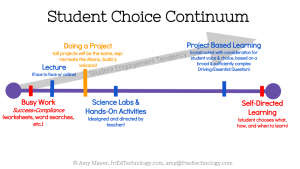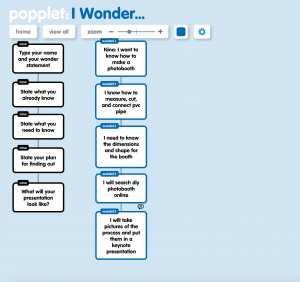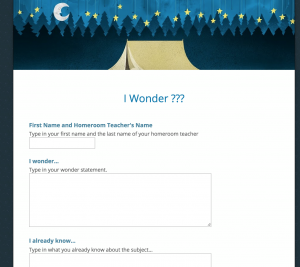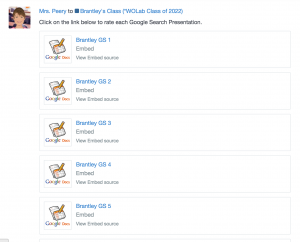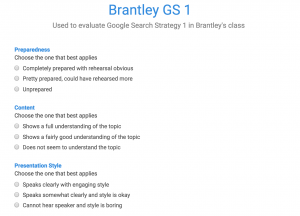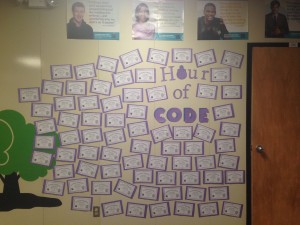Innovative Invention Convention
Mrs. Brantley and I accompanied eleven fourth and fifth grade G/T students to the Region 7 ESC in Kilgore last Wednesday to compete in the Innovation Invention Convention. We invite you to enjoy these scenes from the event with us:
 |
| Another slideshow by Smilebox |
Becoming a Math Wizard
It is that time of year when the 3rd graders have completed their Digital Citizenship project training, assessment, and activities and are ready to move on to something else. I emailed the third grade teachers before the Spring break and asked for their input. From the responses, it appears 3rd graders need additional support in understanding area and perimeter. While scouring the web for ideas, I came across this tweet from Terri Eichholz.
The Pinterest link went to a TEDx talk by Brian Aspinall, a teacher in Ontario. In his talk, he mentions several web based applications he and his students have developed. One of those is Clipkwik. Clipkwik is a web based application that is a google custom search engine. It will search twelve kid friendly websites for videos related to the topic you are searching. By searching for area and perimeter, I was able to find this video that may help the 3rd graders get a better grasp of the meaning of area and perimeter and how to calculate them.
Students will also be introduced to Prodigy. Prodigy is a fairly new web based gaming platform for elementary students. The game is geared to the specific math needs of each individual student. Teachers can create classrooms on the site to enroll students. Once student names are entered, Prodigy will send an email with unique usernames and passwords for students to log in. Prodigy will also send parent letters that contain the student log in information so students can access the website at home. I was first introduced to Prodigy by looking through episodes of Dragon’s Den on Youtube to find student entrepreneur examples to use with the 4th graders. On the episode that originally aired in 2012, the founders of Prodigy pitched their idea to the Dragons, but were not successful in getting funded. Weeks later I came across Prodigy being mentioned through one of the blogs I follow. After initially registering for the site, I wondered if this was the same website that I had come across while watching Dragon’s Den. A simple Google search confirmed my thoughts. The creators of this product were college students at the time they built the website.
Wonder Weeks
I came across a graphic created by Amy Mayer on Twitter the other day, and it explains better than I could why there is so much buzz in education circles about Genius Hour, Passion Projects, and 20% Time. Below is an copy of the graphic, used with permission from Amy:
As teachers, we all strive to insure total engagement from our students. According to Amy’s graphic, the best motivator of student engagement is self-directed learning. A quick look at Twitter and educational blogs will tell you there are plenty of educators who are shifting the focus of their instruction toward this model and sharing a ton of resources along the way. This LiveBinder created by Joy Kirr is just one example. While attending the TCEA Convention in Austin, I sat in on a session by Kirsten Wilson called “The Why of Genius Hour” that helped me formulate what I wanted to do. You can find additional resources by joining the conversation on Twitter using hashtags like #geniushour, #20time, and #passionproject.
The journey will inevitably cause one to cross paths with educators like Will Richardson, who champions the cause that we have to stop talking about “better” when it comes to education and test scores, and start talking about “different.”
I am ready now to do my part to put this education model to the test with my 5th graders. Beginning this week, they will be totally engaged (hopefully) in Wonder Weeks. I chose the title Wonder Weeks instead of Passion Project, 20% Time, or Genius Hour because I wanted to narrow the focus for this project since it is my first try at it. Some teachers focus the student directed learning toward something the student is passionate about or something that will right a wrong or change the world. I wanted to start with something that students could engage with easier. For this project, students will be allowed to research anything they are curious about; hence the name Wonder. I struggled with how to introduce this concept to my 5th graders. There are a host of great videos available that inspire and demonstrate students using the inquiry method to do great things, but they just were not the right fit for what I was trying to accomplish. Then I came across this gem from Joy Kirr’s LiveBinder:
Ways To Wonder – Wonderopolis from Wonderopolis on Vimeo.
I wanted a place to curate students responses so I could not only hold them accountable on a weekly basis, but also to allow me to help them find resources. I explored possibilities with Trello, Padlet, Google Forms, and Popplet. After having some issues with the Popplet site and through a series of emails to their support team, I was finally able to create an account and log in. I have to say that this is a wonderful tool! I created student accounts for each computer I have in the lab. Students are assigned a particular computer at the beginning of the year. I use this same method for students to access Voki and Animoto. Students use the log in for their specific computer. I was easily able to create a mindmap with the information I needed from each student. I then shared the popplet with those 28 accounts. Students will log in with their computer account and contribute to the mindmap, that way I have a visual of all students in the same space. They will also be able to comment on each other’s popples. I think that is AMAZING! Here is what it looks like:
I am still experiencing log in problems from time to time, so I have created a back up plan if students cannot access Popplet. Students will be able to access a Google Form by logging in to Edmodo.
I also wanted a place where students could reflect weekly on their learning. Since all students have their own blog through Edublogs, that is the method they will use. Students will create a new page on their blog called “I Wonder” and spend the last 5-10 minutes of class each week creating a reflective post on how they spent their time.
The proposed timeline for completing this project is as follows:
March 16 – Apr 3 Research
Apr 6 – May 1 Work on Presentation
May 4 – May 22 Presentations
Through this activity, students will learn to formulate a question, research to get information to answer that question, and share what they have learned.
Students will have access to this growing webmix of resources:
Each week I will be introducing students to presentation ideas and tools.
Google Search Lessons
For the past several weeks the fifth graders have been learning about how the Google search engine works and ways to make their searches more meaningful. Students were placed in groups and given two strategies to learn and then present to the rest of their class. There were twelve strategies in all. The videos they accessed were from Dan Russell’s MOOC course called Power Searching with Google. I stumbled across the course a few summers ago and completed the six week course. In the course, demonstrations on how Google works, why word order matters, searching by image, color, specific file type, using operators like OR and AND, putting information in quotation marks, using Google as a calculator, and Google maps were all included. I knew the information in the course would benefit my intermediate students, so last year students watched the videos uploaded in Edmodo and then answered a question. This year I decided they needed a more “hands-on” approach. Students had about three weeks to meet in their groups, study the videos they were assigned, and prepare a way to showcase it to the class. Last week students gave their presentations. The rest of the class evaluated the presentations using a Google Form they accessed from Edmodo. The page they accessed them from looks like this:
and the form looks like this:
Since I have five different classes that come to the lab, and each class had twelve strategies, I had to create small groups in Edmodo to keep the evaluation forms separated by homeroom. I was pleasantly surprised how quick and easy it was to create the form, grab the embed code, and post it in Edmodo. Now that presentations are over, students will be able to see how their classmates evaluated their presentation. From the Google Form response page in my Google Drive, I simply shared the GS documents pertaining to the students in that group with them. They will log in to their gmail account (GAFE) and be able to see how their classmates rated them. Students will compose a short post on their blog reflecting on this activity.
I Am A Troubled Teacher (Updated)
I am in a bad spot. I have come to a cross roads in my thinking of how my class should be run. It is not a safe place. I don’t mean my class, I mean my thinking…what is going on in my head. I feel uncomfortable and uncertain, and I do not like that feeling. I like to know exactly how my day is going to go – pencils sharpened, ipods charged, computers ready, students walking quietly in a row, instructions given and activities completed in the same way at the same time. I am a rule follower who is comfortable with consistency and predictability. I also do my fair share of reading, and it has challenged my understanding of what school should be, so I have decided to let go and give my classroom back to the students. Before I elaborate on where I am going, I need to explain more fully what caused the change in direction.
I happen to teach at an exceptional small public school where the administration has been pushing us to think differently for several years. They are creating a vision where the learning is student directed. I also follow the writings of Terri Eichholtz at Engage Their Minds and John Spencer at Education Rethink. It seems the educationsphere is full of the call to change the education paradigm. This post from my district’s Instructional Technology Specialist is just one example. I just returned from an incredible week of sharing at TCEA‘s Annual Convention in Austin, Texas. It was during Kyle Pace‘s keynote presentation at the Tec-SIG luncheon that I became thoroughly convinced I am missing the mark when it comes to doing what is best for my students. I left with my stomach in knots – not due to the food that was served (it was excellent), but due to the conviction I felt over a video and a statement. Kyle showed the video embedded below:
Then he used this word
The video was not new to me…I had run across it a few years ago while researching Rube Goldberg machines for my G/T students preparing for a Innovation Convention. What surprised me was my reaction to his call to EXPOSE. It hit me that all students have the capability to be incredibly gifted students like Audri, but they are not given the opportunity to be exposed in my classes right now. From everything I have read and seen about Genius Hour, 20% Time, Passion Project, or whatever you may call it, this seems to be a great avenue for that kind of exposure. I realize I am also in a unique position to try a new focus in that in that I am not a traditional classroom teacher. My content area is not subject to a high stakes tests. So begins my journey. Next week my students will be introduced to Wonder Weeks. Stayed tuned for future posts.
YAY For Long Weekends!
Today we celebrate Martin Luther King, Jr.’s birthday, so like a lot of other schools, we enjoyed a school holiday. I spent most of the weekend designing lesson plans and checking my Twitter feed, and I found some jewels. This video by Kid President is certainly worth watching:
This is another jewel I stumbled upon while searching for inspiration for the 4th and 5th grade Invention Projects.
The students will watch this video in Edmodo using the app called Educanon. Educanon allows the facilitator to embed questions in the video. The question will appear and the video is paused until the viewer answers it. This is my first experience using Educanon, but I think it is going to be a very useful way to assign videos for individual viewing while still assessing the level of attention and understanding. I am really grateful that is free and is available in the Edmodo platform.
I found a few other resources that will help my students understand what is involved in the creation process and will enable them to begin asking the questions that lead to innovation and invention, like S.C.A.M.P.E.R. activities and some resources in the Texas Performance Standards Project. I added them as tiles to the Invention webmix in Symbaloo.
The last item I worked on was getting the lesson plan ready for the 3rd graders to create a Voki to embed in their blog. Their Voki will remind viewers of the ten things students do not share online without their parents’ permission. The instructions for the project are in the Moodle course where they take their Web License Test.
Kahoot Toot
image from: https://lifeaccordingtomish.wordpress.com/tag/body-4-believers/
I am officially tooting the horn for Kahoot. Kahoot is a web-based inquiry system where you can engage your students quickly with the curriculum. I first participated in Kahoot at the Region 7 FITT Conference in October in a session with Carl Hooker and discovered very quickly how engaging and fun it is to play. Over the Christmas break, I tried it with my family by choosing Christmas Trivia games that were in the public gallery. The person with the most points chose an inflated balloon out of a gift bag that had currency inserted in it. They popped the balloon to discover a $1, $5, $10 or even $20 bill. We had a blast!
My third graders played a Kahoot created for them called Web License Quiz after the Christmas break to review for their web license test. Every student was 100 percent engaged. I love the aspect of being able to upload images and even video to support the question being asked. I also love the fact that Kahoot not only awards points for the correct answer, but also credits participates for their quickness in answering. To me, this gives the game a competitive edge when compared to similar response systems like Socrative and Poll Everywhere.
It is very easy to create a game in Kahoot. If you are not up to creating your own, there are plenty of games to choose from in the public gallery. The gallery is searchable by title, subject, tag, username, audience, and type of question. If you like one you find in the gallery, you can duplicate it and make changes to it. A good way to differentiate is to take a Kahoot, duplicate it, and then modify it for different audiences. My students love playing so much, they are asking to create their own Kahoot quizzes. Another aspect that I love is students can register for an account and choose the under 16 years of age option. This option protects them from adding their content to the public gallery and browsing anything in the gallery that has not been curated and deemed appropriate.
If you are not familiar with Kahoot, I encourage you to create your account and give it a try!
Hour of Code 2014
Last week, all third through fifth grade students participated in the Hour of Code while in the computer lab during Technology. This was our second year to participate. (Click here to see the post from last year’s event). Students chose from two activities: the Angry Bird platform of the Frozen platform. Each activity had 20 stages, or challenges, interspersed with motivational and instructional videos. At the end of the 20 stages, students could print out a personalized certificate.
The event was scheduled to run during Computer Science Education Week, December 8-12. We held our event a week earlier due to interruptions in our enhancement schedule that week. As last year, EVERY STUDENT SHOWED 100 PERCENT ENGAGEMENT! As you can see from the video below, the elements of critical thinking, problem solving, communication, and collaboration were natural outcomes.

